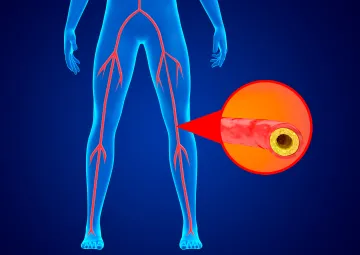Ischemic disease of the lower extremities, also called leg ischemia, occurs when an artery in the leg is partially or completely blocked by plaque, limiting blood flow and reducing the amount of oxygen supplied to the leg.

Patients with leg ischemia often experience leg pain when walking. In a more severe form, patients may experience pain in their feet and toes while resting and may suffer from wounds and skin ulcers on the legs or feet that fail to heal. The Advanced Ischemic Disease of the Lower Extremity program at the University of Arizona is nationally recognized for its expertise in treating this uncommon but potentially deadly disease.
Diagnosis & Treatment
Treatment begins with state-of-the-art diagnosis in the Vascular Lab, where non-invasive technologies allow our surgeons to accurately diagnose the presence and severity or leg ischemia. Interventions for ischemic disease of the lower extremities include angioplasty (inflating a balloon in the artery to dilate it and/or halt the growth of plaque), the use of stents left in place to hold open arteries, probes and catheters to cut or burn away plaque in the arteries, and open surgery to bypass the arterial blockage.
Make an Appointment
For the best surgical care in Tucson, Southern Arizona or the Southwest, make an appointment by calling
(520) 694-6690.
Contact Us
University of Arizona Department of Surgery
Division of Vascular and Endovascular Surgery
PO Box 245072
Tucson, AZ 85724-5072
Office Phone: (520) 626-6670

